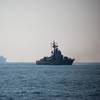President Bush's visit with Coast Guard units in the Port of Philadelphia, Pa., in March placed a well-deserved spotlight on their critical role safeguarding the nation's maritime homeland security. "The men and women of our Coast Guard," the president said, "are showing once again that you are 'Always Ready' to place your country's safety above your own."
Funding increases to the Coast Guard's budget over the past two years have significantly improved the service's current operational posture and readiness. At home, Coast Guard units have been working side-by-side with other agencies in the Department of Homeland Security to ensure the safety of U.S. ports, waterways, and coastal regions. Operational excellence also characterizes operations in the Coast Guard's other traditional missions. Illegal drug seizures during 2002, for example, ranked as the third largest in history. Abroad, the Coast Guard deployed units halfway around the world in 2003 to serve with coalition forces in the liberation of Iraq. Nearly half of the Coast Guard's selected reservists have been activated-a reliable barometer of the pace of today's operational tempo. Support of such Operations as Neptune Shield, Liberty Shield, and Iraqi Freedom demonstrate that today's Coast Guard is more relevant than ever before to the nation's maritime tasks at hand.
Looking to the future, the contract award for the Integrated Deepwater System to Integrated Coast Guard Systems (ICGS, a joint venture between Lockheed Martin and Northrop Grumman) in June 2002, marked a critical step toward the Coast Guard's long-term goal to design and build a force equal to the task of fulfilling a broad range of increasingly challenging multi-mission requirements in the 21st century. Deepwater's estimated $17-billion recapitalization program entails far more than the progressive replacement of the Coast Guard's aging inventory of cutters, fixed-wing aircraft, and helicopters over the next 20 years. Rather, it is an integrated approach to upgrade existing legacy assets while transitioning to newer and more capable manned and unmanned platforms-including highly improved systems for command, control, communications, computers, intelligence, surveillance, and reconnaissance (C4ISR) and logistics assets.
The Integrated Deepwater System represents an enduring contribution to the maritime needs of the nation. This complex and incredibly challenging program will provide a foundation on which to build the Coast Guard's performance, capabilities, and capacity for many years to come-including important contributions to the long-term confrontation that we know as the war on terror. As I remind audiences at every opportunity, the need is real. The time is now.
A Focus on the End in Mind
Earlier this year, Deputy Secretary of Homeland Security Gordon R. England emphasized the importance of a results-oriented outlook in meeting the nation's defense and security needs. "I believe the key test for homeland security is not inputs, but outcomes," the deputy secretary said. "Success must be measured by the capabilities we create with the resources we have - capabilities to protect more people, deter more terrorist acts, and reduce and eliminate more vulnerabilities."
The Deepwater program's acquisition strategy has established a sharp focus on this necessary "end in mind" through its cutting-edge "system-of-systems" approach for the design and development phases of the Coast Guard recapitalization of its Deepwater assets and systems. Our industry partners are obliged to satisfy capabilities-based system performance specifications based on the overarching goals of maximizing operational effectiveness and reduced total-ownership costs for the entire Deepwater system.
Deepwater does not follow the past Coast Guard procurement practice of replacing assets on a one-for-one basis. As an alternative to traditional platform-centric procurement, Deepwater's acquisition strategy calls for the delivery of an entire system of interoperable platforms and supporting systems designed to meet performance-based requirements. The IDS Mission Need Statement expresses this requirement for a systems solution: "The goal of this effort is not to replace ships, aircraft, and sensors with more ships, aircraft, and sensors, but to provide the Coast Guard with the functional capabilities required to achieve mission success safely."
This overarching focus on a system-wide acquisition outcome obliged industry to view Deepwater performance requirements in their entirety in order to develop an integrated strategic plan that ensured asset comparability and interoperability, while providing high levels of operational effectiveness and the most affordable solution for U.S. taxpayers.Cost is treated as an independent variable in the IDS acquisition progra; this approach is essential if the Coast Guard is to remain within planned annual expenditures of $500 million (in fiscal year 1998 dollars adjusted for inflation) over the life of the program. The program also is unusual for its efforts to reduce total ownership costs to the lowest possible level.
Our ICGS partners in industry were provided with the performance specifications needed to achieve system-wide capabilities. This approach allows industry to leverage state-of-the market technologies and bring its innovation and industrial capacity to bear most effectively. Commercially available "state-of-the-market" and non-developmental items will be the basic building blocks for Deepwater's assets and components.
Industry also was required to provide a performance-measurement plan to support its solution to Coast Guard requirements. The quality of our industry team's performance plan and metrics will allow the Coast Guard to measure and track performance against our fundamental requirement to maximize operational effectiveness while minimizing total ownership costs. Risk is inherent in any acquisition program of this magnitude, but a comprehensive mitigation strategy is in place to address risks associated with the program's cost, schedule, and performance.
A System of Systems
When the transformational Deepwater program is fully implemented, the total ICGS system will consist of upgraded 123-ft. (37.4-m) Island-class patrol boats, three classes of new cutters and their associated small boats, new and upgraded fixed-wing maritime patrol aircraft, a combination of upgraded and new helicopters, and both cutter-based and land-based unmanned air vehicles.
The Deepwater program will provide the Coast Guard with the operational capabilities, capacity, platforms and systems necessary to focus on the prevention of attacks on the U.S. homeland. In addition, Deepwater's more capable platforms also will benefit the Coast Guard's other traditional missions, including maritime safety, the protection of natural resources, maritime mobility and national defense. Most importantly, Deepwater assets will be supported by fully interoperable C4ISR (command, control, communication, computers, intelligence, surveillance, and reconnaissance) and an Integrated Logistics System (ILS).
Deepwater's C4ISR system will be a critical enabler in allowing the Coast Guard to develop maritime domain awareness - comprehensive information, intelligence, and knowledge of all relevant entities in the U.S. maritime domain that could affect U.S. security, the U.S. economy and environment. This knowledge will lead directly to improved risk management, the more productive employment of operational assets, and a common operational picture. Deepwater's more capable platforms and C4ISR system will greatly expand surveillance and detection efforts. Capabilities also can be cascaded to other agencies as new joint competencies are forged.The importance of robust C4ISR capabilities is well-recognized as the sine qua non for effective military and maritime operations. As Michael Mohr, Sweden's assistant under secretary for defence, said recently at a maritime security conference in April, "The first and most important part of the [network-centric force] concept is to connect our forces in an information network-to let information and intelligence flow in near-real time to all who need it." Deepwater's Integrated Logistics System (ILS) will, in many ways, provide the solid foundation needed to support this extraordinary transformation of the Coast Guard's operational capabilities. The integration of ILS performance specifications across air, surface, and C4ISR domains will help to drive platform designs as such factors as optimal manning, supportability, maintainability, reliability, and total ownership costs are incorporated-leading eventually to higher operational readiness, improved safety, and lower operating expenses.
In short, the Integrated Deepwater System will make important contributions to the transformation of the Coast Guard's C4ISR and logistics systems. Improvements to operational capabilities also will be made in the surface and air domains.
Surface and Air Domains
During the years ahead, the Coast Guard's legacy force will be progressively upgraded and recapitalized as new and more-capable cutters, aircraft, and unmanned aerial vehicles (UAVs) are introduced to the fleet. The first five years of the program will see considerable progress.
For example, in February, the 110-ft. (33.5-m) cutter USCGC Matagorda became the first of 49 Island-class patrol boats to enter the Bollinger shipyard in Lockport, La., to undergo conversion to a 123-ft. (37.4-m) vessel with upgraded operational capabilities. Modifications include the fitting of a stern ramp to enhance small boat launch-and-recovery operations. The Short-Range Prosecutor, a new seven-meter boat, will add to the patrol craft's capabilities. A new deckhouse, new berthing compartments, a new galley, an improved air-conditioning system, and other enhancements will improve habitability and quality of life for the crew when they are underway.Three new classes of cutters (the National Security Cutter (NSC), the Offshore Patrol Cutter (OPC), and the Fast Response Cutter (FRC)), are being designed from the keel up. The first NCS will enter service in 2006. These new cutters will be more seaworthy and include reconfigurable spaces that can be tailored for specific missions. Crew size, which is the most significant factor affecting a ship's total life-cycle costs, will be reduced through a variety of means, including a greater reliance on automated systems, by incorporating design requirements based on human-centered engineering principles, lessons learned from the Coast Guard's cutter-crewing analysis and past experiences in recent DOD acquisition programs and studies.
Other planned improvements include:
• Large hangars that will accommodate a mix of helicopters and UAVs;
• A 360-degree bridge to enhance operational awareness and safety;
• Dual-gender berthing accommodations to enable more flexible crew assignment;
• Enhanced stability to enable small boat and air operations in higher sea states.
As an outgrowth of the National Fleet Policy Statement between the Navy and the Coast Guard, I signed a Memorandum of Understanding with Rear Adm. Charles Hamilton II, the Navy's deputy program executive officer for ships, in April 2002 and established a working group to commit our respective Program Executive Offices to specify common technologies, systems, and processes critical to both the Navy's future Littoral Combat Ship (LCS) and the Coast Guard's future National Security Cutter and other surface platforms.
This cooperation and collaboration reflect my obligation and determination to ensure that the Integrated Deepwater System is totally interoperable, wholly compatible, and completely seamless with the Navy's recapitalization programs. This linkage is supported with regular meetings and exchanges at all levels in our staffs to ensure that we will derive mutual benefits through a cooperative technical approach in areas of common interest. A number of the Coast Guard's assigned missions, for example, have the possibility of high commonality with LCS mission areas. Close cooperation and, when it makes sense to do so, collaboration will allow our two future forces to obtain common benefits as our programs mature. The LCS design construct of modularity, scalability, flexibility, and transformational capabilities is the right direction to address our joint naval requirements and to ensure a seamless intersection between our two services in providing for the maritime security and defense of the littorals. Deepwater's recapitalization of Coast Guard aviation assets also is moving forward. Modern systems and equipment will be retrofitted on several existing classes of fixed-wing aircraft and helicopters, and detailed designs will be finalized during the years ahead for follow-on assets slated for new production.
In addition to planned upgrades to legacy platforms, ICGS proposals include a mix of new aircraft and UAVs, but IDS recapitalization planning retains sufficient flexibility to adopt other platforms should options offering a better mix of operational capability and value be developed in the future.
Profound Expertise
Much of the past year's activity associated with the implementation of the Deepwater acquisition strategy has entailed the formation of partnerships with a wide range of players. In addition to Deepwater's partnering with ICGS, the Navy, and other agencies in the Department of Homeland Security, we seek to create other joint competencies where and when it makes sense to do so. The profound expertise demonstrated by our public and private partners complements the Coast Guard's proficiencies enormously.
There is excellent potential, for example, for similar partnering opportunities around the world. The Deepwater International Office serves as a critical link between the IDS program and the international community. Our long-range goal is to achieve heightened cooperation and interoperability with U.S. allies, increased efficiency in the acquisition program, and worldwide visibility of the technological superiority that the Integrated Deepwater System offers to navies around the world to address their 21st-century security requirements. As Commandant of the Coast Guard Adm. Thomas H. Collins said earlier this year in his Status of the Coast Guard address, the current and future readiness of the Coast Guard "… depends entirely on obtaining the right capabilities, the right capacity, and the right partnerships with others."
The Integrated Deepwater System is on course to achieve its end in mind in each of these areas-a firm guarantee that tomorrow's Coast Guard will be even more capable of fulfilling its role as America's "sentinels of the sea."
Featured videos

Unlock Onboard Data Efficiencies

Inmarsat Enhances Service to Drive Digitalization

Tracking Foreign Vessels Working in the U.S. Jones Act Market
Subscribe for
Maritime Reporter E-News
Maritime Reporter E-News is the maritime industry's largest circulation and most authoritative ENews Service, delivered to your Email five times per week









